| |
Liver Fibrosis Progression in Hepatitis C Virus Infection After Seroconversion: FIB-4 scores doubled in the first 4 years after infection and more than 18% of them developed cirrhosis within 10 years after infection, our data would suggest treating early
|
| |
| |
Download the PDF here
".....we found that among HCV+ persons the mean FIB-4 scores doubled in the first 4 years after infection and more than 18% of them developed cirrhosis within 10 years after infection. It might be argued that HCV-infected persons have certain behavioral characteristics (eg, more alcohol use) that may predispose them to faster progression of liver disease....White race was associated with a 51% higher risk of developing cirrhosis compared with nonwhite race among HCV+ persons.......If newer treatments demonstrate slowing or reversal of fibrosis progression and delaying development of cirrhosis, our data would suggest treating early in the course of infection. On the other hand, if the cirrhosis has already set in, treatment may be helpful in preventing hepatic decompensation in only a small number of those with cirrhosis, since the number who go on to develop this complication is small.....it is important to rigorously study the effect of early treatment on liver disease progression and development of cirrhosis and hepatic decompensation"
"The association of hypertension with liver fibrosis progression is a novel and interesting finding. Hypertension and insulin resistance have been associated with a diagnosis of nonalcoholic fatty liver disease. A recent study has demonstrated that persons with fatty liver had a higher risk of developing hypertension independent of multiple confounders, and resolution of fatty liver reverted the risk to baseline"
"Our study shows that fibrosis progression after HCV infection starts early and that a substantial proportion of HCV-infected persons develop significant fibrosis or cirrhosis within the first 5 to 10 years of infection. On the other hand, progression of cirrhosis to hepatic decompensation is uncommon in the first 9 years after cirrhosis. To our knowledge, this is the largest study of HCV-infected persons with a relatively precise estimation of the time of infection, and it provides important information about natural history of HCV infection."
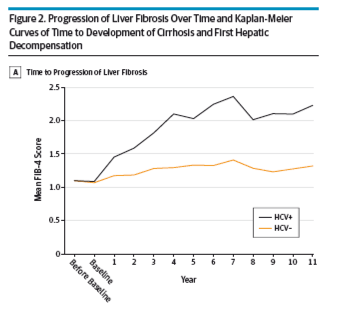
Among HCV+ persons, factors associated with a higher risk of cirrhosis were increasing age, white race, hypertension, history of alcohol abuse or dependence, and anemia. Among HCV- controls, only alcohol abuse or dependence and anemia were associated with a higher risk of cirrhosis. When persons with diagnosis of alcohol abuse or dependence at baseline were removed, only age was significantly associated with a diagnosis of cirrhosis among HCV+ persons (eTable 1 in the Supplement).
we determined the risk factors for hepatic decompensation in HCV+ and HCV- persons (Table 2). Diabetes, hypertension, and anemia were associated with a higher risk of developing hepatic decompensation among HCV+ persons, while alcohol abuse or dependence was the only factor significantly associated with this outcome in HCV- group. When patients with a diagnosis of alcohol abuse or dependence were removed, hypertension and anemia remained significantly associated with a diagnosis of hepatic decompensation in the HCV+ persons (eTable 2 in the Supplement).
We also determined the cumulative proportion of persons who developed cirrhosis after each year of follow-up using FIB-4 for diagnosis (Table 3). At 5 years, more than 15% of HCV+ persons had a diagnosis of cirrhosis, compared with less than 5% in HCV- controls. Finally, we determined the number of persons who developed a hepatic decompensation event annually after the diagnosis of cirrhosis per year. While the overall number of events was very small, the numbers in HCV+ persons were higher than HCV- controls. In addition, more than half of hepatic decompensation events occurred within 2 years of cirrhosis diagnosis (Table 3).
Our study presents a somewhat different picture than other studies of liver disease progression after acute HCV infection. In a study of 155 Irish women infected by contaminated anti-D immunoglobulin, no cases of cirrhosis were observed after 22 years of follow-up
--------------------
Liver Fibrosis Progression in Hepatitis C Virus Infection After Seroconversion
JAMA Intern Med. Published online December 08, 2014
Adeel A. Butt, MD, MS1,2; Peng Yan, MS2; Vincent Lo Re III, MD, MSCE3; David Rimland, MD4; Matthew B. Goetz, MD5; David Leaf, MD, MPH5; Matthew S. Freiberg, MD, MSc1,2; Marina B. Klein, MD6; Amy C. Justice, MD, PhD7,8; Kenneth E. Sherman, MD, PhD9 ; for the ERCHIVES (Electronically Retrieved Cohort of HCV Infected Veterans) Study Team
ABSTRACT
Importance Knowing the rate of liver fibrosis progression in hepatitis C virus (HCV)-infected persons can help inform patients and providers (clinicians, medical institutions or organizations, and third-party payers) in making treatment decisions.
Objective To determine the rate and factors associated with liver fibrosis progression and hepatic decompensation in persons after acquiring HCV infection.
Design, Setting, and Participants Secondary data analysis of persons in the Electronically Retrieved Cohort of HCV Infected Veterans (ERCHIVES), a national Veterans Affairs (VA) database, between 2002 and 2012. Among 610 514 persons in ERCHIVES (half were HCV positive), we identified those with an initial negative and subsequent positive test result for HCV antibody and positive HCV RNA test result (HCV+). Controls had 2 negative HCV antibody test results (HCV-) in a comparable time frame and were matched 1:1 on age (in 5-year blocks), race, and sex. We excluded persons with human immunodeficiency virus, hepatitis B, less than 24 months of follow-up, hepatocellular carcinoma, and cirrhosis at baseline.
Main Outcomes and Measures Progression of liver fibrosis as estimated by the Fibrosis-4 (FIB-4) index; development of cirrhosis, defined by a FIB-4 score greater than 3.5; and development of hepatic decompensation.
Results The evaluable data set consisted of 1840 persons who were HCV+ and 1840 HCV- controls. The HCV+ persons were younger and had a lower mean (SD) body mass index (27.39 [5.51] vs 29.49 [6.16]; P < .001), a higher prevalence of alcohol and drug abuse and dependence diagnoses, and higher serum aminotransferase levels, but had a lower prevalence of diabetes and hypertension. Fibrosis progression started early after infection among HCV+ persons and tapered off after 5 years. A total of 452 cirrhosis and 85 hepatic decompensation events were recorded. After 10 years of follow-up, HCV+ persons were more likely to have a diagnosis of cirrhosis compared with HCV- controls (18.4% vs 6.1%). Nine years after diagnosis of cirrhosis, hepatic decompensation events were uncommon but had a higher rate in the HCV+ group (1.79% vs 0.33%).
Conclusions and Relevance Persons who seroconverted for HCV have a more rapid progression of liver fibrosis and accelerated time to development of cirrhosis after seroconversion compared with HCV- controls. Fibrosis progression occurs early after infection; however, hepatic decompensation is uncommon after diagnosis of cirrhosis.
INTRODUCTION
Studying clinical consequences of hepatitis C virus (HCV) infection is often limited by the lack of knowledge of actual time of infection. Our understanding of the natural history of HCV infection has mostly been gained from studies with small numbers of participants, single-source outbreaks, or high-risk target populations.1- 3 In many previous studies, participants were those who were referred to specialty clinics and/or those who consented to undergo liver biopsy on 1 or more occasions. To improve our understanding of the course of chronic HCV infection and clinical consequences arising from it, a relatively precise estimate of the time of infection with adequate follow-up time in a large national, geographically diverse sample and appropriate HCV-uninfected controls are needed. An added advantage of using noninvasive markers over liver biopsy, which is the gold standard, is that they can be obtained at multiple time points for large populations.
Hepatitis C virus is a slowly progressive chronic disease. Many HCV-infected patients do not develop liver-related complications even after many years of infection. Because the most severe consequences of chronic HCV infection are due to liver disease, it is important to define the rate of progression of liver fibrosis and hepatic decompensation and the potential mediators of these consequences. To address these issues, we used the Electronically Retrieved Cohort of HCV-Infected Veterans (ERCHIVES), a well-established national cohort of HCV-infected veterans and corresponding HCV-uninfected controls, to identify patients who tested positive for HCV antibody during follow-up, after at least 1 prior negative HCV antibody test result. Our primary aim was to determine the rate of liver fibrosis progression among HCV-infected persons and uninfected controls, with a relatively well-defined time of HCV seroconversion. We also determined factors associated with development of cirrhosis and hepatic decompensation among these persons.
METHODS
Data Sources
The study was approved by the institutional review board of the Veterans Affairs (VA) Pittsburgh Healthcare System. Appropriate approvals were also obtained from individual data sources, where required. We used the third iteration of the Electronically Retrieved Cohort of HCV Infected Veterans (ERCHIVES 3.0) to identify newly diagnosed HCV-infected persons and HCV-uninfected controls between October 1, 2001, and September 30, 2012. The earlier versions of ERCHIVES have been previously defined.4- 10 In ERCHIVES 3.0, we identified all HCV-infected persons in the VA health care system between October 1, 2001, through September 30, 2012 (VA fiscal years 2002-2012). Persons infected with HCV were identified based on a positive HCV antibody test result (HCV+), and HCV-uninfected persons, matched on age (in 5-year blocks), sex, and race/ethnicity, were identified based on a negative HCV antibody test result (HCV-) performed in the same year. Clinical and demographic information was retrieved from the National Patient Care Database, pharmacy information from the Pharmacy Benefits Management database, and mortality information from the Beneficiary Identification Records Locator System and the VA death file. Laboratory data were retrieved from the Corporate Data Warehouse. Data from these multiple sources were merged using previously established algorithms.
Study Patients
For the current analysis, we identified persons who were HCV antibody negative on initial testing but had at least 1 subsequent positive HCV antibody test result and no subsequent negative test result ever as well as at least 1 positive HCV RNA result after the positive antibody test result. The actual time of infection was assigned to be the midpoint between the last negative and first positive test result. Controls were persons who were HCV antibody negative within 1 year of the corresponding HCV-infected person testing positive, plus at least 1 more negative test result within 1 year of the first negative result to account for the initial testing bias.
We excluded persons with HIV infection, hepatitis B surface antigen positivity, cirrhosis, and hepatocellular carcinoma, as well as those with no laboratory values available to calculate baseline Fibrosis-4 (FIB-4) score. Patients who received any treatment for HCV were included but censored at the time of HCV treatment initiation for time-to-event analyses. Retained patients were further required to have at least 24 months of follow-up in the VA health care system after initial diagnosis as well as availability of at least 1 FIB-4 measurement available after 24 months of baseline.
Baseline was defined as the midpoint between last HCV- and first HCV+ date for cases and the midpoint between the 2 negative test results for controls. Time at risk started from the baseline date for each group till the time of first diagnosis of cirrhosis (when cirrhosis was the outcome, determined by FIB-4 score), first HCV treatment date, first hepatic decompensation event, death, or last observation date in ERCHIVES.
Other Definitions
The FIB-4 index was chosen as the measure of fibrosis progression based on previously published data suggesting its utility to detect liver involvement in HCV-infected persons. The FIB-4 score provides an estimation of degree of liver fibrosis using routinely obtained blood tests11- 13 and was computed as follows:FIB-4 = age [years] x AST [IU/L]/platelet count [platelets x109/L] x (ALT1/2[IU/L]),where AST indicates aspartate aminotransferase; and ALT, alanine aminotransferase.
Laboratory data were obtained at yearly intervals, and FIB-4 score was calculated using these values. When available, the mean of 3 values closest to the chosen time point (Ī6 months) was used to calculate FIB-4 score. For baseline values, only values prior to baseline were used. For FIB-4 score calculations, age was kept constant at baseline. Liver cirrhosis was defined as a FIB-4 score greater than 3.5, as per several previous publications using these cutoffs.
Comorbid medical and psychiatric diagnoses and history of alcohol and drug abuse diagnoses were extracted at baseline and were based on laboratory values (for the variables described in the following paragraph) or the presence of at least 1 inpatient or 2 outpatient International Classification of Diseases, Ninth Revision (ICD-9) diagnoses. The utility of these diagnoses have been previously demonstrated.14- 17
Patients were considered to have diabetes if they met any of the following criteria: (1) glucose level of 200 mg/dL or greater (to convert to millimoles per liter, multiply by 0.0555) on 2 separate occasions; (2) ICD-9 codes (≥2 outpatient or ≥1 inpatient) plus treatment with an oral hypoglycemic or insulin for 30 days or more; (3) ICD-9 codes (2 outpatient or 1 inpatient) plus glucose level of 126 mg/dL or greater on 2 separate occasions; (4) glucose level of 200 mg/dL or greater on 1 occasion plus treatment with an oral hypoglycemic or insulin for 30 days or more.18 Chronic kidney disease was defined as an estimated glomerular filtration rate lower than 60 mL/min/1.73 m2 on 2 separate occasions at least 90 days apart, as calculated by the simplified Modification of Diet in Renal Disease equation.8 Hepatic decompensation was defined as a primary hospital discharge diagnosis or 2 or more outpatient diagnoses for ascites, spontaneous bacterial peritonitis, or esophageal variceal hemorrhage. In a previous study by our group in a similar setting, 91% of events using this definition were confirmed by medical records.19 Anemia was defined as a hemoglobin level lower than 13 g/dL (to convert to grams per liter, multiply by 10) for men and lower than 12 g/dL for women.
Outcomes
Our main outcome measures were (1) progression of liver fibrosis by as estimated by FIB-4; (2) development of cirrhosis, defined by FIB-4 score greater than 3.5; and (3) development of hepatic decompensation. We performed additional analyses using the AST to platelet ratio index (APRI) as a measure of liver fibrosis progression and cirrhosis, using a cutoff value of greater than 2.0 for cirrhosis. These analyses are presented in eTables 1 and 2 in the Supplement.
Analysis
The HCV+ group included persons who had detectable HCV RNA after HCV antibody positivity and no subsequent undetectable value. The control group included HCV- persons matched to each HCV-infected person. Baseline characteristics were compared using the χ2 test or t test as appropriate. Factors associated with subsequent development of cirrhosis or hepatic decompensation were determined using multivariable Cox regression analysis, including all listed covariates in the model. Because alcohol use can also have an acute impact on liver complications, we performed a sensitivity analysis after excluding all persons with a diagnosis of alcohol abuse and dependence in the 12-month period prior to baseline, as well as during follow-up. Assumptions of proportionality were tested using Schoenfeld residuals. Kaplan-Meier plots were generated to show and compare time to development of cirrhosis and first hepatic decompensation event among the study groups. P < .05 was considered statistically significant when comparisons were made. We used SAS (SAS Institute Inc) and Stata version 11 (StataCorp) software for statistical analyses.
RESULTS
Patient Characteristics
Within the ERCHIVES data set (610 514 persons, 1:1 matched at baseline for HCV antibody positivity, age in 5-year blocks, race, and sex), we identified 10 966 persons who had an initial negative and a subsequent positive HCV antibody test result. We excluded persons diagnosed as having HIV infection (n = 536); those with hepatitis B surface antigen positivity at baseline (n = 197); those with a diagnosis of hepatocellular carcinoma at baseline (n = 15); those missing FIB-4 or APRI data at baseline or after 24 months in care (n = 3433); those with a cirrhosis diagnosis at baseline (n = 218); and those with no HCV RNA value available (n = 2560). A total of 517 patients received treatment for HCV and were censored at the time of HCV treatment initiation for time-to-event analyses. After these exclusions, there were 1840 HCV+ persons available for analysis. We then identified the same number of age- (in 5-year blocks), race/ethnicity–, and sex-matched controls who were HCV antibody negative within 1 year of HCV-infected person testing positive, plus at least 1 more negative test within 1 year of the first negative result. Exclusion criteria for this group were similar to the HCV+ group (Figure 1).
Baseline characteristics of the subjects are provided in Table 1. Compared with HCV- persons, HCV+ persons were younger, had a lower mean (SD) body mass index (27.39 [5.51] vs 29.49 [6.16] [calculated as weight in kilograms divided by height in meters squared]; P < .001), had a higher prevalence of alcohol and drug abuse and dependence diagnoses, and had higher serum aminotransferase levels, but had a lower prevalence of diabetes and hypertension. The median time between last negative and first positive HCV antibody test result was 41 months (interquartile range, 18.5-65.0 months).
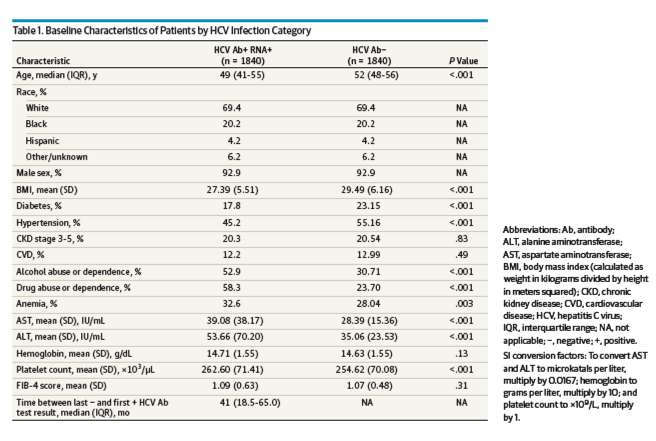
Progression of Hepatic Fibrosis and Diagnosis of Cirrhosis Over Time
We plotted the mean FIB-4 scores over time to visually present the progression of liver fibrosis over time (Figure 2A). Because serum aminotransferase levels may be elevated in acute infection and then return to a "set point," we added a time point for FIB-4 calculation prior to seroconversion, using the time closest to, but before, the last HCV negative test result. Fibrosis progression started early and was most pronounced within the first 5 years but continued over a period of 11 years. Progression was persistently higher among those who were HCV+. Because alcohol use can also acutely affect AST and ALT levels and give spurious FIB-4 results, we performed a sensitivity analysis removing all persons with a diagnosis of alcohol abuse and dependence in the 12-month period prior to baseline. This did not alter the results significantly (eFigure 1 in the Supplement).
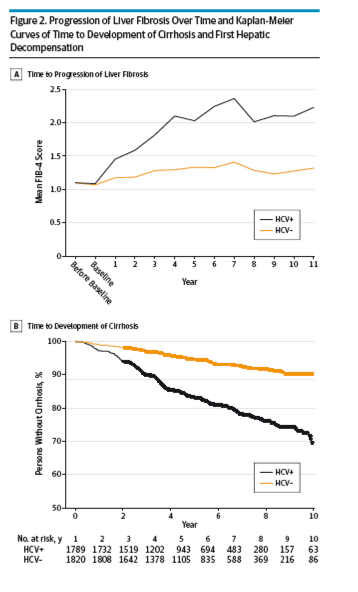
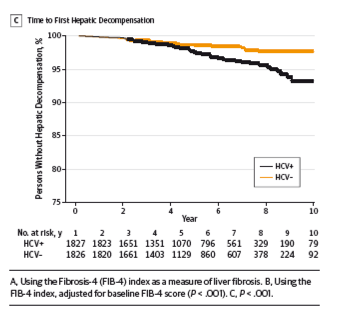
We then estimated time to development of cirrhosis using the FIB-4 index with adjustment for baseline FIB-4 score (Figure 2B). A total of 452 cirrhosis diagnoses were recorded-339 in the HCV+ group (18.4%) and 113 in the HCV- group (6.1%). Compared with HCV- persons, HCV+ persons had a significantly shorter time to development of liver cirrhosis. Removing patients with baseline and subsequent diagnoses of alcohol abuse or dependence determine cirrhosis did not alter the results significantly (eFigure 2 in the Supplement).
We then estimated time to initial hepatic decompensation event. There were a total of 85 hepatic decompensation events recorded-57 in the HCV+ group (3.1%) and 28 in the HCV- group (1.4%). Compared with HCV- persons, HCV+ persons had a significantly faster time to first hepatic decompensation event (Figure 2C). Removing patients with baseline and subsequent diagnoses of alcohol abuse or dependence did not alter the results significantly (eFigure 3 in the Supplement).
Factors Associated With Cirrhosis and Hepatic Decompensation
Table 2 provides the demographic and clinical factors associated with a diagnosis of cirrhosis in each of the groups. Among HCV+ persons, factors associated with a higher risk of cirrhosis were increasing age, white race, hypertension, history of alcohol abuse or dependence, and anemia. Among HCV- controls, only alcohol abuse or dependence and anemia were associated with a higher risk of cirrhosis. When persons with diagnosis of alcohol abuse or dependence at baseline were removed, only age was significantly associated with a diagnosis of cirrhosis among HCV+ persons (eTable 1 in the Supplement).
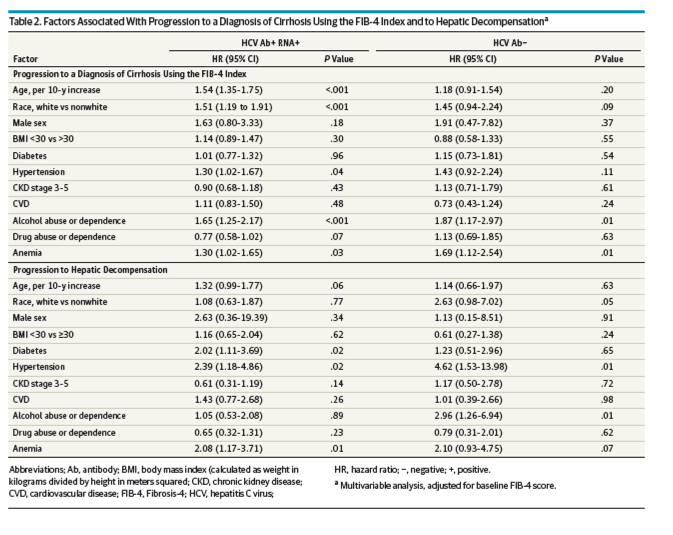
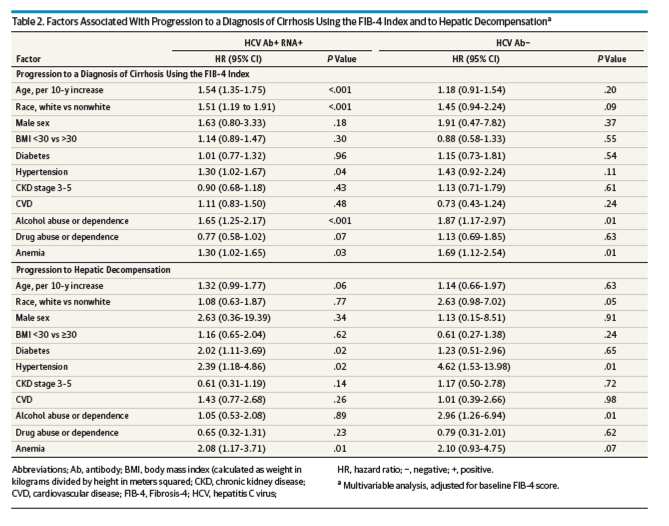
Finally, we determined the risk factors for hepatic decompensation in HCV+ and HCV- persons (Table 2). Diabetes, hypertension, and anemia were associated with a higher risk of developing hepatic decompensation among HCV+ persons, while alcohol abuse or dependence was the only factor significantly associated with this outcome in HCV- group. When patients with a diagnosis of alcohol abuse or dependence were removed, hypertension and anemia remained significantly associated with a diagnosis of hepatic decompensation in the HCV+ persons (eTable 2 in the Supplement).
Additional Analyses
Hepatitis C virus genotype results were available for 521 patients among the HCV+ group. Of those, 395 (75.8%) were genotype 1, 52 (10.0%) were genotype 2, 66 (12.7%) were genotype 3, and 8 (1.5%) were genotype 4. While these numbers are small, the rate of fibrosis progression, time to cirrhosis, and time to first hepatic decompensation event were similar in genotype 1 vs non–genotype 1 individuals (data not shown).
We also determined the cumulative proportion of persons who developed cirrhosis after each year of follow-up using FIB-4 for diagnosis (Table 3). At 5 years, more than 15% of HCV+ persons had a diagnosis of cirrhosis, compared with less than 5% in HCV- controls. Finally, we determined the number of persons who developed a hepatic decompensation event annually after the diagnosis of cirrhosis per year. While the overall number of events was very small, the numbers in HCV+ persons were higher than HCV- controls. In addition, more than half of hepatic decompensation events occurred within 2 years of cirrhosis diagnosis (Table 3).
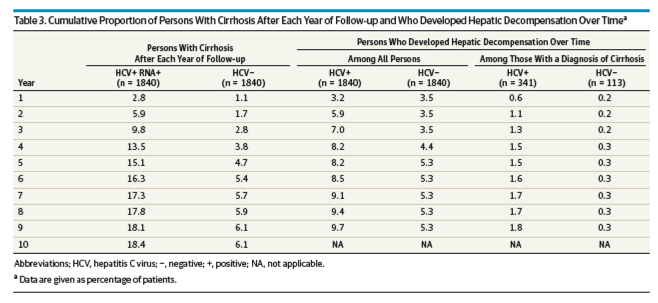
We determined fibrosis progression and development of cirrhosis using the APRI as a marker of these outcomes. The results were similar to primary analyses using the FIB-4 index and are presented in eFigures 4 and 5 in the Supplement.
DISCUSSION
Our study shows that fibrosis progression after HCV infection starts early and that a substantial proportion of HCV-infected persons develop significant fibrosis or cirrhosis within the first 5 to 10 years of infection. On the other hand, progression of cirrhosis to hepatic decompensation is uncommon in the first 9 years after cirrhosis. To our knowledge, this is the largest study of HCV-infected persons with a relatively precise estimation of the time of infection, and it provides important information about natural history of HCV infection. Because our study participants were not limited to a single outbreak and our study was not geographically limited and did not comprise a convenience sample of those who consented to repeated liver biopsies, it presents important information of several outcomes of interest in this population.
Our study presents a somewhat different picture than other studies of liver disease progression after acute HCV infection. In a study of 155 Irish women infected by contaminated anti-D immunoglobulin, no cases of cirrhosis were observed after 22 years of follow-up.2 In another study of 547 patients with parenterally acquired HCV (116 HIV+ and 431 HIV- patients), only 2.6% of the HCV-monoinfected persons developed cirrhosis in the first 10 years after infection.3 In other smaller studies (39-135 patients) from the United States and Europe of transfusion-associated non-A, non-B hepatitis, cirrhosis was observed in 8% to 24% of the patients after 8 to 14 years of follow-up. These studies were limited by the fact that the time of HCV infection was estimated by history in most studies, and HCV infection was confirmed in most, but not all, cases.20- 24 Retrospective studies have also estimated the mean interval between transfusion and diagnosis of cirrhosis to be approximately 21 years.25- 27 Using a widely used noninvasive marker of liver fibrosis (FIB-4 index), we found that among HCV+ persons the mean FIB-4 scores doubled in the first 4 years after infection and more than 18% of them developed cirrhosis within 10 years after infection. It might be argued that HCV-infected persons have certain behavioral characteristics (eg, more alcohol use) that may predispose them to faster progression of liver disease. We analyzed our data after excluding those with a diagnosis of alcohol abuse or dependence, and the result trends were similar, indicating that HCV itself plays a role. Chronic HCV infection has been associated with a higher risk of hepatic steatosis, which can also lead to an elevated liver enzyme level and higher FIB-4 score. However, steatosis is often associated with higher body mass index, but HCV+ persons in our study had a lower body mass index. The role of hepatic steatosis needs to differentiated from the effects of HCV itself through further studies.
The association of hypertension with liver fibrosis progression is a novel and interesting finding. Hypertension and insulin resistance have been associated with a diagnosis of nonalcoholic fatty liver disease. A recent study has demonstrated that persons with fatty liver had a higher risk of developing hypertension independent of multiple confounders, and resolution of fatty liver reverted the risk to baseline.28
Studies have shown that hepatic stellate cells are the principal hepatic fibrogenic cells generating scar tissue in response to persisting liver injury. These cells express functional adrenoceptors, and catecholamines and neuropeptide Y can induce characteristic profibrotic phenotypic changes in these cells. These receptors are up-regulated in nonalcoholic fatty liver disease–associated cirrhosis, and a general overstimulation of the sympathetic nervous system in fatty liver may potentially partially explain this association.29 Whether higher blood pressure exerts an independent effect on liver fibrosis in HCV-infected persons and the mechanism of this association need further study.
Another interesting finding in our study is the association of white race with a diagnosis of cirrhosis. White race was associated with a 51% higher risk of developing cirrhosis compared with nonwhite race among HCV+ persons. Similar associations have been observed in HCV-infected persons on dialysis, where survival was worse in patients who were white compared with other races.30 Whether this is a reflection of risk factors for acquisition of HCV, other behavioral factors, genetic factors, or other unknown factors remains to be established.
The strengths of our study include a very large, national sample with a long follow-up. We also had a relatively precise time of infection because we had the last negative and first positive HCV antibody test result. There are also several important limitations that need to be considered when interpreting these results. Even though we have a relatively precise estimate of time of infection, the median time between last negative and first positive HCV antibody test result was 41 months. The FIB-4 index is not the gold standard for hepatic fibrosis evaluation, though it has been found to be useful in this regard. Laboratory values were not gathered uniformly as part of a prospective study but were obtained during the course of routine clinical care. We did not have enough data on HCV genotype. It is known that certain genotypes are associated with more liver histologic abnormalities, though this has been more evident with steatosis than fibrosis. We did not have the risk factors for HCV infection; hence, the effect of mode of acquisition of HCV on liver fibrosis progression could not be assessed. Diagnosis of alcohol use was based on ICD-9 codes, which may lead to a misclassification of some patients. However, with such a large data set, we anticipate the misclassification effect to be diluted and to be relatively similar across study groups. We also performed an analysis removing all persons with a diagnosis of alcohol abuse and dependence, and the results were comparable.
Results from our study may have implications in policy making and treatment decisions for HCV-infected persons. Treatment regimens for HCV are now available, which lead to sustained viral eradication in excess of 90% of treated persons. However, these treatments are very costly. Identifying persons with a higher risk of disease progression can help determine those in immediate need of treatment vs those in whom treatment may be safely deferred until simpler and cheaper therapeutic regimens are available. If newer treatments demonstrate slowing or reversal of fibrosis progression and delaying development of cirrhosis, our data would suggest treating early in the course of infection. On the other hand, if the cirrhosis has already set in, treatment may be helpful in preventing hepatic decompensation in only a small number of those with cirrhosis, since the number who go on to develop this complication is small.
CONCLUSIONS
In our study, HCV-infected persons had a more rapid progression of liver fibrosis and accelerated time to development of cirrhosis. With newer therapies that eradicate HCV in over 90% of treated persons, it is important to rigorously study the effect of early treatment on liver disease progression and development of cirrhosis and hepatic decompensation.
|
|
| |
| |
|
|
|